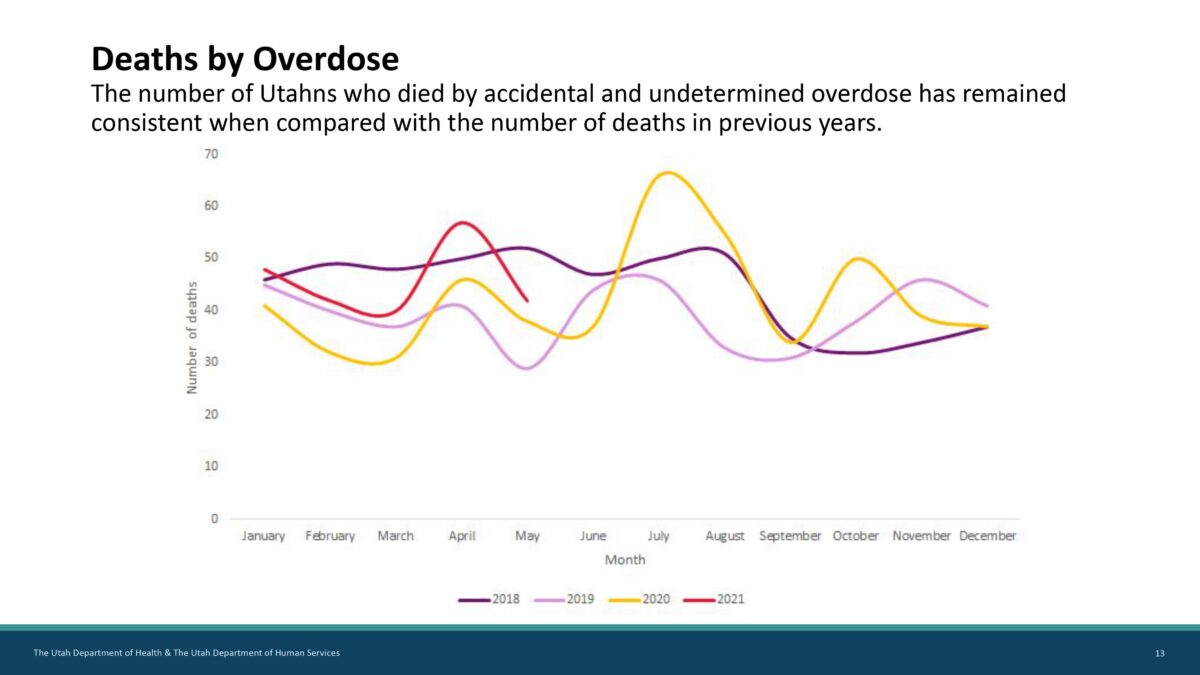Report: Little change during pandemic of still-high suicide, overdose deaths in Utah
- NUHOPE held it’s 10th annual Northern Utah Suicide Awareness Walk on Saturday, Sept. 23, 2017, in downtown Ogden.
- This chart presented as part of the 2021 Utah Suicide & Overdose Report shows the number of deaths by suicide per month from 2018 to 2021.
- This chart presented as part of the 2021 Utah Suicide & Overdose Report shows the number of drug overdose deaths per month from 2018 to 2021.

SARAH WELLIVER/Standard-Examiner
NUHOPE held it’s 10th annual Northern Utah Suicide Awareness Walk on Saturday, Sept. 23, 2017, in downtown Ogden.
SALT LAKE CITY — New data released by the Utah Department of Health shows the number of suicides and overdose deaths in Utah have not increased during the COVID-19 pandemic despite continuing to be a serious problem across the state.
The report, released Thursday by the UDOH and the Suicide Prevention Coalition, shows although the nation overall shows suicide and drug overdose increases since the beginning of the pandemic, Utah has not seen any changes between March 2020 and June of this year.
“This isn’t over. We are still in the midst of a pandemic and things can still change,” said Michael Staley, suicide prevention research coordinator with the UDOH. “Utah rates were high going into this pandemic and while they haven’t increased, they remain consistent. One death is one too many. The work of preventing suicide will never be over until we reach zero.”
Each year, around 640 Utahns die by suicide and 6,500 are treated in hospital emergency rooms. Key findings from the report show the number of Utahns who died by suicide has remained statistically unchanged since January 2015, with no changes in suicides for any age group. In addition, the overall trend in the number of Utahns who went to the emergency room after attempting suicide or for thoughts of suicide did not change between January 2020 and August of this year. The number of Utahns who died by accidental or undetermined drug overdose from March 202o to the end of May 2021 remained consistent with the number of deaths in previous years.
“There’s no doubt the pandemic has placed additional stresses on individuals, families and communities. But the fact is, the vast majority of people effectively manage crises, serious mental illness and extremely difficult circumstances. The typical response to multiple stressors and crises is resilience and recovery, and we are seeing that in our data so far,” Staley said.

Image supplied, Utah Department of Health and Utah Department of Human Services
This chart presented as part of the 2021 Utah Suicide & Overdose Report shows the number of deaths by suicide per month from 2018 to 2021.
The Utah Suicide Prevention Coalition also released its Utah Suicide Prevention State Plan for 2022-2026. The plan includes steps to address the issue. Interventions are outlined in the new plan, which was developed by suicide prevention professionals, researchers, health care workers, LGBTQ+ advocates, survivors, family members and others affected by suicide. It serves as an important tool to guide prevention work and policy throughout the state over the coming years.
Allison Foust, suicide prevention program administer with the Utah Department of Human Services and co-chair of the Utah Suicide Prevention Coalition, said prevention works, treatment is effective and people can and do recover from suicidal thoughts, feelings and behaviors, but it’s critical for people around them to watch for signs and ask straightforward questions.
“Overdose and suicide are two major issues in our state and nation and they are largely preventable,” Foust said. “There’s a lot of information outlined in this plan including reducing the stigma around mental and behavioral health issues, teaching coping skills for youth and adults, and providing support for people.”
Foust said it’s critical that the public recognize and learn the warning signs of suicide. Those can include someone saying they want to go to sleep and never wake up; withdrawing from friends, family and previously enjoyed activities; sleeping too much or too little; changes in mood; tying up loose ends and giving things away; and saying if “such and such happens” they are going to kill themselves.
Getting care in a timely manner is critical for people experiencing increased emotional, mental or substance use-related concerns. Seek help for yourself or for someone you care about by calling 800-273-TALK (8255) or visiting liveonutah.org. Resources for those seeking help for substance use can be found at 211utah.org or opidemic.org.

Image supplied, Utah Department of Health and Utah Department of Human Services
This chart presented as part of the 2021 Utah Suicide & Overdose Report shows the number of drug overdose deaths per month from 2018 to 2021.
Copies of the data report are available at coronavirus.utah.gov/Mental-health. The Utah Suicide Prevention State Plan 2022-2026 is available at liveonutah.org/about.






